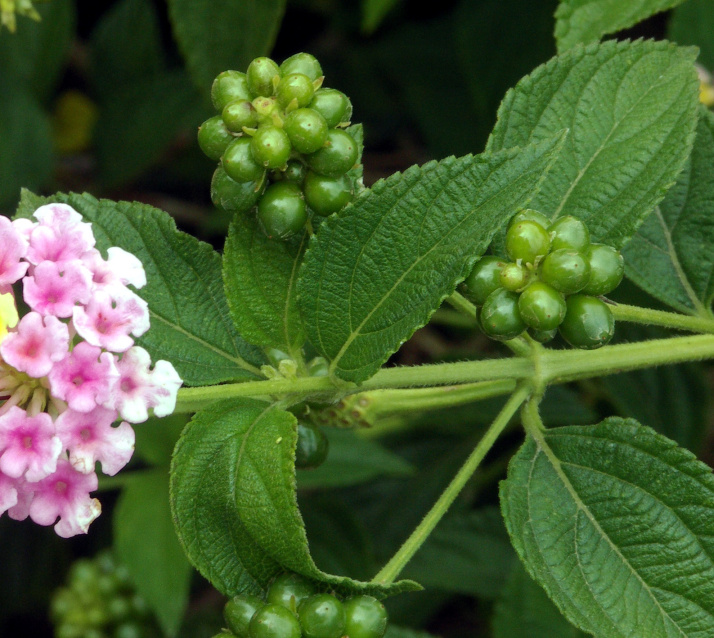Lippia multiflora Moldenke
| Botanical Name | Lippia multiflora Moldenke |
| Order: | Lamiales |
| Family: | Verbenaceae |
| Genus: | Lippia |
| Species: | L. abyssinica |
| Common Names: | Bush tea; Gambian tea bush; Healer herb; Ti-tree English), The de Gambie (French). |
Plant Synonyms
Lippia adoensis hochst.; Lippia grandifolia hochst.
Plant Local Names
Burkina Faso: Moore - Kwilg-wisaore. Dioula - Kangaliba, Fulfulde - Legal café
Cote d'lvoire: Anyi - Amaniena, Kalango - Akankoino, Maninka - Sonugca Suba
Gambia: Fular-Usumbolomo, Maridika- Killiba (Sisilinghyamo), Wolof - Mbormbor Ghana: Akan - Sre-Nunum, Ga - Naasuruu, Ewe - Afudoti (Afu)
Guinea: Fula Pu;aar – Bahe, Susu – Diohuli
Mali: Fula Pulaar - Bahe-Bahe, Manding bambara - Gane Ba
Nigeria: Fula Fulfulde - Dirisi, Yoruba - Efinrin- Gogara Fefe
Senegal: Balanta - Brege, Serer - Mbalat, Diola - Busag
Sierra Leone: Temre - A-Kimbo
Togo: Tem - Fasau Klouto - Avudati, Ewe –Nyone
Plant Habitat
Guinea and coastal savannah; also in tropical West Africa
Plant Material of Interest
Leaf, Root; whole plant.
Plant Description
A stout woody, aromatic perennial shrub; stems ridged, shortly pubescent, simple leaves, oblong lanceolate, thick texture, dentate margin, lateral veins 7-8 pairs, bluish-green; flower whitish, sweet-scented; branched inflorescence.
Plant Used Parts
Plant Uses
Lippia is a popular plant with a long history of use as an aromatic tea in African traditional medicine and other parts of the world. The leaves are used as a hot beverage and a tea-like infusion for fevers, gastrointestinal disturbances, enteritis, coughs and colds. Rural communities in some parts of W. Africa take Lippia tea after a hard day's work to relax and enhance sleep, while in urban areas the tea is drunk in the morning to relieve stress. In Ghana and Nigeria, an infusion of the leaves is used for the treatment of malarial and microbial infections (Kerharo and Adam, 1974; Kunle et al., 2003; Ajaiyeoba et al., 2004). The tea is also used traditionally as an antihypertensive, and a laxative. A drink made from the bolied leaves and palm nut is used to expel placenta after delivery (Burkill, 1997; Irvine, 1961). In Mali the powdered leaf is used in the production of a remedy for treating malaria (Diallo et al., 2004).
Plant Therapeutic Action
Adjuvant for cosmetics (oil) ; antihypertensive; antimalarial; antimicrobial; diuretic; laxative; mouth disinfectant (locally) ; muscle relaxant; sudorific (Pelissier, 1994; GHP, 1992).
Plant Precaution for Use
Caution should be taken in the administration of the aqueous extract in patients with compromised liver and renal function especially at high doses.
Plant Adverse Effect
Sedating; purging, possible increase in liver transaminases, creatinine and urea at high doses.
Plant Contraindication
Hypotension, elderly, pregnancy and lactation and antihypertensive medications.
Plant Dosage Forms
Infusion; tincture; spray
Plant Dosage
Infusion: 30 g dried leaves in 600 ml of water; 3-4 teacups daily
Tincture: 1:5 in 45% alcohol; 5 ml three times daily
Plant Storage
Store in a cool dry place in covered containers
Plant Chromatographic Fingerprint
Analytical TLC on silica gel G60 F254, 0.25 mm
layer in petroleum ether (40-60 °C)/chloroform [2:8], detection in daylight, after spraying with anisaldehyde (0.5 ml) mixed with 10 ml glacial acetic acid, 85 ml methanol and 5mI concentrated sulphuric acid and heated to 100-110°C for 5-10 min. Presence of five characteristic spots with Res 0.66 (violet), 0.51 (violet), 0.42 (pink), 0.38 (pink) and 0.29 (pink).
Plant Constituents
Volatile oil: (linalool, camphor, terpineol, thymol and other monoterpenes); flavonoid; saponin (glycoside) (Pelissier, 1994; GHP, 1992).
Plant References
Abena, A.A., Ngondzo-Kombeti, G.R., Bioka, D. (1998). Psychopharmacologic properties of Lippia multiflora[Article in French], Encephale, 24(5): 449-454.
Addae-Mensah, I. (1992). Towards a Rational scientific Basis for Herbal Medicine: A phytochemist's Two-decade Contribution. An Inaugural Lecture delivered at the University of Ghana, Legon, 45. Ghana Universities Press: Accra.
infections-a survey and an observation. African J Med Sci., 33(2):115-119.
Burkill, H.M. (1997). Useful plants of West tropical Africa Volume 1, Botanical Gardens Kew.
Diallo, D., Maiga, A., Diakite, C,, Willcox, M. (2004). Malarial-5: development of an antimalarial phytomedicine in Mali. In Traditional Herbal Medicines for Modern times: Traditional medicinal plants and Malaria edited by Merlin Willcox, Gerard Bodeker and Philippe Rasoanaivo, CRC PRESS, London, pp 117-130.
Ghana Herbal Pharmacopoeia (1992). The Advent Press: Accra, Ghana.
Irvine, F. R. (1961). Woody Plants of Ghana. Oxford University Press.
Kerharo, J., Adam, J.G., (1974). La Pharmacopee Senegalaise Traditionnelle: Plantes medicinales et toxiqifes, Editions Vigot freres Paris.

